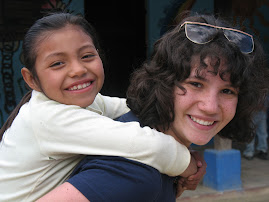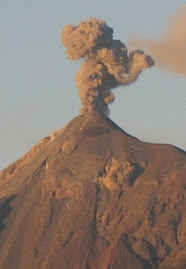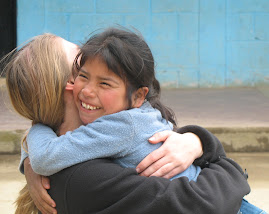The trees here seem sharper, harsher against their backgrounds than in Florence, Italy. The tropical vegetation is moist and green, a darker shade than what I am used to seeing. As we walked along the dirt road in El Hato, Guatemala we passed communities made up of tiny tin-roofed houses; their yards decorated with brightly colored laundry hung out to dry. As we travel through Guatemala, Mexico, El Salvador, and Honduras, I notice how everything is more colorful. In our tight-knit group of 16 independent Traveling School women, we spent a day laughing, playing and practicing our Spanish with children at the village school before making our way back home in the evening.One of my favorite parts about dinner is when we are all done eating and we gather together for schedule. I am always bursting with excitement over what will come next. Here in Central America, I am continuously intoxicated by my surroundings. With so much going on, and so much to do, it is a nice break to wear the same clothing day after day. Here we are in a real world school for 3 1/2 months and do not have time for the shallow high school stress of always looking stylish. We are all gorgeous with our dirt encrusted fingernails, hairy legs, and unruly hair.It is an interesting lifestyle we have here at The Traveling School; migrating from place to place, perfecting our routines of continuously breaking and setting camp as we go. By the end of this trip we will all be professional nomads. I am growing accustomed to feeling unsettled; that is the beauty of being nomadic. Although we experience sadness for the people and places we are constantly leaving behind, there is always more to come; always the anticipation, thrill, and attraction of discovering a new place. I love the traveling life.As we drive in our minivan shuttles, we take in magnificent views; our eyes follow lines of waving trees stretching vastly across green valleys to tickle the bottom of mountains in the distance. The grassy expanses are freckled with roaming cows and humble homes. Colorful clothing swaying on clotheslines flirt coyly with the breeze. The sky a spectacular gradient of merging blues complimented by the tranquility of floating clouds; pillows of the divine.Life on the river is mellow and everyone is allowed to be laid-back and have a great time. Rafting the Rio Lacanja, we barely navigated down steep cascades (waterfalls), swam in the river, and laughed over flipping boats. The stunning blue water added to the magical ambiance.The giant Mayan ruins stood majestic amongst the trees and flowers. I imagined the ancient Mayans gazing across this land, once enchanted with rich stories and full of life. On more than one occasion that day I had to do a double take, just to confirm that I was in fact looking at a plant growing on a ruin in Tikal and not a mystical tribesman of the past. I knew there were untold stories whispering along with the breeze, ancient tales ingrained onto every vein on every tropical green leaf, secrets carved into the bark of every tall swaying tree, and timeless music slithering through each blade of grass I walked through. When we reached the top of the temple of the Sun God of Palenque, the world lay before us. I stood there panting, utterly enthralled. The wind whipped my hair into tangled chaos. The surface was uneven. I turned around, laid on my back, and viewed the world upside down for a moment. It all made me wonder . . .What memories might I be able to hear?Should I listen to the silent flirting between the grass and the wind,Or gaze between the cracks of the trodden path upon which we trekked?Surely there must be forgotten stories scattered across the landscape,Stories of ancient nature and wisdom that now only the land can pass on,Should I find the right pair of ears.After arriving to the top of the Mirador to look upon the view, the scene before me took the little breathe I had left away. In a sudden burst of inspiration, I found myself awake and full of new awareness. I felt so grateful for everything I could feel, smell, see, and hear; it was one of those rare moments in which I simply cannot believe this is reality and I am not dreaming. Those moments are becoming ever more common for me these days.Cesar, our guide through Tikal´s Mayan ruins, held up an enormous tarantula that made me giggle nervously with the grandeur of its deadly presence. Its size alone was stunning; never had I imagined that a tarantula could be so menacing.Throughout this ever-changing journey of new experiences, I find that the fascinating people I meet light up my soul and change my world the most. I recall waving to some local children as I drove to Antigua from the airport in Guatemala City, on the first day of the semester. My heart warmed to see so many little faces split with grins. Soon, all of us girls were waving, inspired by a contagious joy that can only be spread though the connection of human souls.
"Viene, Viene!" whispered Kelsea, an unbelievably sweet-faced little girl with numerous curls bobbing up and down from top of her head, exaggerated eyelashes and an irresistible smile. Pulling gently on my skirt, she guided me away from the view of the gentle rolling waves towards the sand-floored library in Chiquistepeque, Guatemala. Children in this petite sun-kissed village have a hard life. They are woken up and put to sleep by the roaring engines of motorcycles flaunting the wealth of the hollering riders. Little kids stand tip-toe, trying to look out the wooden framed windows of their thatched-roofed houses, longing to be one of the loud people driving expensive rides. The economic disparity that exists here results in loss of self-esteem and motivation. Anna and Elfego started a non-profit organization called Hemacas y Pescado to combat the negative impacts of this great financial divide and to provide the local children with some inspiration. The couple rents out rustic cabanas, scattered peacefully around their beach-front property, for a small fee. Visitors are welcome to join in on the activities and spend quality time with the children. This organization started out with a few local kids and now manages a large, excited group of 74. Kelsea slipped her small mango-covered hand into mine and lead me towards a tower of books. Standing before the bookshelf was little Jason. Though small, I think he is going to be a rapper when he grows up. He and adorable Juan sat together with their hands in rapper-like formation, bobbing their heads up and down. Kelsea and I looked into each other´s eyes, both inevitably squinting from our chuckles. We picked up the first book and got lost in stories ranging from Barney to Winnie the Pooh. I was very impressed with Anna, the coordinator I was working with. She is warm-hearted and joyful with just the perfect hint of strictness. If I was a child here I would try to please her too. The children´s voices still echo in my mind and I hear their giggles when I look out to sea.
Playing with food
What do you get when you mix pesty bugs, heat, humidity, and 16 white girls in the middle of a cobblestone street in Juayaya El Salvador? To some, it may have appeared to be a freak show, but in reality, it was a group of American girls making an Alfombra out of Mother Nature’s ingredients. An Alfombra is literally a "carpet" made of colored sand laid out along the route of the holy week processions. Our design, comparable to the Sistine Chapel, filled the street outside our hostel. Fathers, sons, mothers, and daughters strolled slowly by, gawking at the masterpiece being created by the enthusiastic gringas. A cool breeze carrying salty, greasy scents form the nearby plaza constantly interrupted our work. Pulsing bass beats emanating from pickups driven by teenagers carried us through this intensely creative process. Many people passing by mumbled "bonito." The ceiba tree made of wood chips we designed was bonito; the red heart on the tree made of beans was bonito; the blue sky made of dyed-blue salt was bonito. Once done, we were left with a brilliantly colored Alfombra, grins on our faces, compliments in our ears, and blue ink on the tips of our fingers.
Perfect. Love. Perfect.
The 85 degree ocean water was not as refreshing as it looked. Still a welcome escape from the intense El Salvador sun, we pranced and frolicked through the crashing waves of Punta Roca in la Libertadad.
“I just tasted the pacific ocean,” my classmate Biz exclaimed after inhaling a face full of water. I do not think I have ever felt so connected to the natural world simply diving through the waves. For the first day of our surfing lesson our instructors, “Papa” and Mario, pushed us into the waves. Soon Mario had me catching my own. With a surf board strapped to my ankle, my usual fear of the ocean’s waves melted away with the day’s heat. Being carried by a wave is the most liberating sensation, like riding a bike down a very long hill with the wind in your eyes. A spark of addiction ignited within me in first the first hour and a half and I felt as if I understood why some develop such a binding attachment to the sport. Every once in a while, I would actually stand up, and sometimes I even stayed up for more than a second. These moments inspired me and made me hunger for more. Eventually, my arms grew tired, but I never wanted to stop. I never grew cold and the more I stood up (however briefly) the more I craved the waves. Indeed, I became frantic for more, and the sight of the curling short wall of water approaching me resulted in an uncontrollable urgency to get on the board.
Paddle. Go!
Sometimes I would have a conversation with a fellow classmate while waiting for a wave. Finally, we would spot one big enough tocatch and shout mid-sentence,
“This is it!"
We rode those tiny waves that probably looked flat-out pathetic to the more experienced surfer. To us, those rides simply fanned the flames of our new found addiction; wipe out after salty wipe out. As our session ended, the hot sun reflected off of our arms clutching the boards and our hair styled by the will of the current and the angle of our falls.
Perfect. Love. Perfect.
PEACE (of My Heart) CORPS
I wrap my arms around Tim, a Peace Corps volunteer from Kansas who hosted my classmates and I for four days in the small village of El Pital, El Salvador. I do not want to let go for the fear of this experience truly coming to an end. A couple of seconds later I slowly ease my arm muscles and my eyes shut tight gating my tears. The words, ¨thank you," catch the breeze and do not reach Tim. Maybe that is a good thing because ¨thank you¨ seems like a lame attempt to express the gratitude I feels towards Tim for allowing me to visit his village.
I pick up my backpack and heart off the concrete floor and drag myself onto the booming chicken bus, which is blasting the same five songs I have heard over and over during my three month long journey through Central America. I gaze out of the window and watch El Pital shrink in the distance. What could my new friends and family be doing right now? Are the best dancers, Edwin, Otto, and Leo practicing the 1980´s dance moves I taught them the night before at our dance party? Are they working? Or, are they talking about the latest news on the "Mara 18," a feared gang that commands streets from Los Angeles all the way down to El Salvador. Are the girls we had in our life skills class reading the goals they set for the next ten years like they promised or are they patting tortillas for the evening meal?
I drift away and daydream about the morning we gathered young people, ages five to twenty-two, together to paint rocks and lamp posts with us. The beautiful artwork will keep the government from suffocating the village with political graffiti and glossy presidential candidate pictures. I smile thinking about the hour and a half hike to the reward of a refreshing pool of water with a small waterfall along side it. The most incredible feeling comes when I think about what a significant impact us gringas had on the girls we interacted with. Tim told us that most of the girls came on the hike but few had the courage and confidence to go into the water. They were too embarrassed. As soon as they saw us, young gringas, swimming in the water, they cannon-balled in.
The bus begins to slow down and I arrive at my new destination, though I am still reminiscing about my time in El Pital. Just maybe, I will follow in the admirable footsteps of Tim, as a Peace Corps volunteer, and return to the petite village to reclaim my heart.




